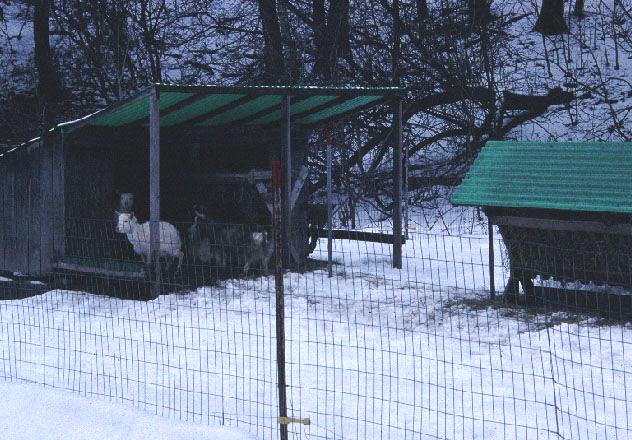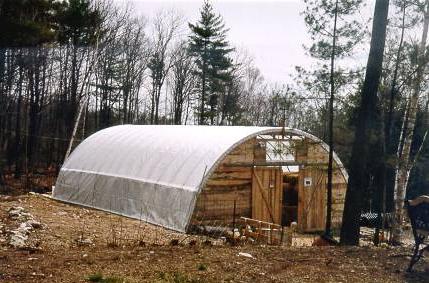Housing and Working Facilites for Goats
Introduction
Goats by nature are very tolerant of all kinds of weather and can adapt to many different styles of housing, some of which can be simple and inexpensive. Despite their hardiness, when goats are under extreme wet and drafty conditions for long periods of time they are vulnerable to respiratory infection and hypothermia. For that reason ideal housing should keep goats dry and protected from such conditions. Goats usually seek cover from rain, snowy conditions, and hot sunny weather. Their production of meat and milk is not effected when the temperature is between 0 and 55° F. The most important time for housing, however, is during winter months when the does are kidding. Choosing ideal housing depends on the purpose of the goat operation; whether it is for meat, milk, or fiber, or just to enjoy having a goat.
The two principal categories for housing design are open housing and confinement housing. Open housing, or loose housing, allow goats to have protection from weather conditions while giving them open access to pasture. Confinement housing contains the goats totally within the structure and often includes a separate area for exercise which is outside and adjacent to the building. Any system should have the ability to separate groups of animals such as milking does, dry (non-lactating) does, newborn kids, growing kids, and bucks. Whichever type of housing used it is vital to know all the rules and regulations with respect to location, design, and type of operation. Also, appropriate building permits should be obtained. Speaking with an experienced builder or contractor can help to ensure the facility and equipment of the building is suitable for the cost; considering the size and intensity of the operation.
Best Management Practices
Open Housing

Open sided structures or sheds for loose housing are appropriate for goats in most conditions and provide a more natural environment for the animal. There are many types of structures used for open housing such as three-sided pole barns, framed sheds, and many types of movable or temporary structures such as calf-hutches or hoop greenhouses.
| Advantages | Disadvantages |
|---|---|
| Less expensive to build. | More bedding is usually required. |
| Easier access to machinery for manure removal. | Boss goats can be a problem due to their ability to intermingle freely with other goats. |
| Freedom of movement allows for weight gain from exercise. | |
| Excellent air circulation and quality. |
Recommendations
- To minimize draft, the open portion of the structure should face the south, or away from prevailing winds. In extreme weather conditions the open side can be made smaller, provided the number of goats does not limit the required space in the enclosure.
- Creating a bedded pack by adding more bedding on top of the existing bedding reduces the frequency of manure removal. A bedded pack can stay dry and warm but it is important to clean out periodically. Wet bedding can cause formation of harmful gases, odors, bacteria, parasites, and worms.
- Adding clean gravel over dirt floors helps keep bedding drier. Use at least four inches of bedding material on a sloped gravel floor when starting a bedded pack.
- The required floor space for the bedded area in lose or open housing should be at least 10 – 15 sq. ft. per mature goat. An additional 25 sq. ft. should be provided per goat for exercise either in or outside of the structure. Separate pens for kidding should provide a minimum of 4 ft. by 5 ft. bedded area.
- The area for water and feeding troughs should be separate from the bedded area to prevent contamination of the feed from fecal material which can be a source of parasites.
Confinement Housing

Existing old barns and buildings can be easily renovated for excellent goat housing. Management of the herd and maintenance of the building is usually more complex but sometimes easier than with an open housing system.
| Advantages | Disadvantages |
|---|---|
| Improved conditions from inclement weather for humans | New construction is expensive |
| More supervised management | Animals need to be turned out to exercise |
| Less bedding is used | Frequent removal of spoiled bedding |
| Easier access in order to handle individual animals | Ventilation system needed and checked frequently |
Recommendations
- An outdoor lot is not an absolute requirement but it is beneficial to have a separate space for exercise, which should provide a minimum of 25-sq. ft. per animal.
- Having good ventilation is essential. Inadequate air exchange can cause respiratory problems from an accumulation of respiration gases, volatile gases from manure, dust, and mold from excessive moisture. There are many different designs for ventilation for both cold housing and warm housing. Primary types of ventilation are natural ventilation, a mechanical system, or both. (See resources section below).
- Walls and ceiling must be free of condensation. Install proper insulation and ventilation up to code. Sunlight coming through south facing windows provides a source of Vitamin D for the goats and helps with drying and warmth in the winter. During summer months the windows can be removed to help increase air exchange. Recommended window space is one to two feet for each goat being housed.
- Goats in confinement barns require 15-sq. ft. per animal if in pens. Individual stalls should be at least six-sq. ft. and equipped with feeders and water.
- Free-stall and tie-stall housing, similar to the types used in bovine dairy operations, are designed for goats. (See resources section below)
Note: Many already existing structures can be turned into housing for goats provided they meet density, age and breed requirements.
Resources
The Pennsylvania State College of Agricultural Sciences, Cooperative Extension has a full listing of plans for goat housing, feeders, and other management equipment including milking parlors. These plans are of a historical nature but do offer useful designs and ideas for adapting existing barns and sheds to a goat operation. This resource can be found at http://agsci.psu.edu/
Although related to bovine dairy facilities, this article provides good information on natural ventilation systems. It can be accessed at http://abe.psu.edu/extension/idea-plans/goat/ip-728-26